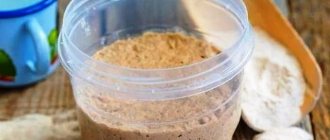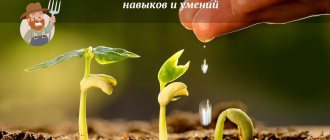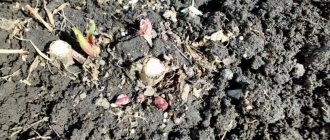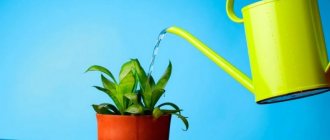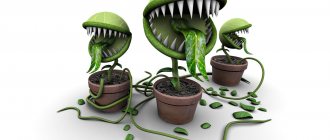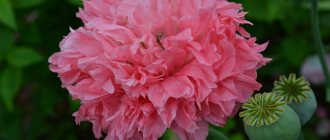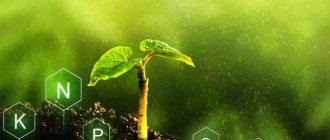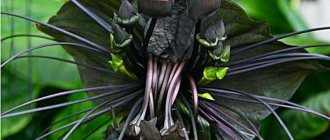- Fertilizer release forms.
- Macro- and microelements in fertilizers for indoor plants.
- What types of nitrogen fertilizers are there and what plants need nitrogen.
- Types of nitrogen fertilizers.
- What kind of soil should nitrogen fertilizers be applied to?
- What plants need nitrogen?
- Potassium fertilizers for indoor plants.
- How to determine potassium deficiency in a plant?
- Types of potash fertilizers.
- Which plants need potassium?
- All about phosphorus fertilizers.
- Phosphorus deficiency in plants - diagnosis.
- Types of phosphate fertilizers.
- Which plants should be fed with phosphorus fertilizers?
- Manure for fertilizing indoor plants.
- The benefits of peat as a fertilizer.
- Using bird droppings to fertilize plants.
- Compost for fertilizing plants.
- Is sawdust a fertilizer?
- Bone meal is a very effective organic fertilizer.
Plants, like all living organisms, need vitamins and minerals. And if “street” inhabitants receive all this from the outside, then with indoor plants things are different. Just imagine that we replant many indoor plants no more than once every 2-3 years, and sometimes less often. During this time, we water them as the soil dries out, but by replenishing the plants with life-giving moisture, we simultaneously wash out from the soil all the useful minerals that are so necessary to maintain a lush crown, flowering and growing season. And during the flowering period, all plants cannot do without additional nutrition , because the poor fellows use all their strength on this process, and without replenishing (with our help) their strength they can completely wither and die. In this case, you need to know how to quickly revive a houseplant.
Fertilizer release forms.
Liquid fertilizers Granular or compressed fertilizers Powdered fertilizers Long-acting fertilizers in the form of tablets or sticks
The market currently offers a huge variety of fertilizers for indoor plants. For example, there are the following forms of fertilizer release:
- liquid fertilizers
- granular fertilizers
- fertilizers in powder form
- long-acting (prolonged) fertilizers in the form of sticks.
Important! Liquid fertilizers are best absorbed by plant roots.
| Liquid fertilizers | Granular fertilizers | Fertilizers in powder form | Long-acting (prolonged) fertilizers in the form of sticks or tablets. | |
| Description. | They are a concentrate of salts in liquid form. | Fertilizers in the form of small lumps (granules). Free-flowing and non-caking. The size of the granules varies from 1.5 to 4 cm. | Fertilizers in the form of dry powder. Bulk. | They have the form of a medical tablet or a stick of compressed fertilizer. |
| Mode of application. | Dilute the concentrate in water in the proportions recommended in the instructions. | Mix directly with soil. | Mix directly into the top layer of substrate. Can be mixed not only with soil, but also with coconut and similar substrates. The second method of application involves dissolving powder fertilizer in water and watering. | Locally. The stick must be inserted into the top layer of soil. The quantity depends on the volume of the pot. |
| Impact and effectiveness. | Of the fertilizers presented, they are considered the most effective, due to better absorption by the roots of the plant. | Efficiency is average. With each watering, beneficial microelements are gradually released from the granules. | High efficiency. Fertilizing with powder fertilizers can be done no more than once every 3-8 weeks, depending on the type of powder fertilizer chosen. | Efficiency is lower. It has a prolonged effect, microelements are released when watering. Due to local exposure, microelements are distributed unevenly and do not always reach the roots of the plant. |
| Possibility of foliar feeding. | Eat. Does not replace root feeding. Used in addition to root feeding. | No. | Eat. Foliar feeding is carried out with a powder solution diluted in water. | No. |
| Price. | The most expensive compared to granular or pressed ones. | Not tall. | High. From 700 rub. per pack 125 grams. | Not tall. |
Macro- and microelements in fertilizers for indoor plants.
To nourish indoor plants, macro- and microelements are needed. Macronutrients are needed in large quantities and include nitrogen, potassium and phosphorus. Microelements are also necessary to maintain plant life, but in much smaller quantities than macroelements. These include: calcium, sulfur, molybdenum, iron, copper, manganese, boron, magnesium .
Nitrogen, phosphorus and potassium in the life of indoor plants.
The whole variety of fertilizers, of any format and consistency, can be divided into two huge categories of fertilizers - mineral and organic.
Instructions for use of potassium chloride
Potassium chloride has a high potassium content. The substance is actively used in agricultural technology when it is necessary to replenish nutrients and normalize the development of gardening and ornamental crops. Can be used in complex feedings, together with nitrogen-phosphorus components.
Benefits of application:
- increasing the “immunity” of plants;
- disease prevention;
- increasing the frost resistance of perennials;
- improved adaptation to temperature changes;
- reducing the likelihood of crop dehydration;
- positive effect on fruit formation;
- improving the quality of the resulting horticultural products;
- increasing the shelf life of the harvested crop.
It is important to strictly follow the dosages recommended by the manufacturers, since excess application often reduces soil fertility.
Potassium chloride can be granular and fine, and also differs in varietal characteristics:
- granules or crystals of the first grade are compressed, irregular in shape, have a grayish-white or brownish-red color;
- granules of the second grade, represented by large crystals of grayish-white color.
Rules of use:
- potatoes, tomatoes and other vegetable crops - add under digging at the rate of 100 g of potassium chloride for every 10 m²;
- garden plantings - applying 150 g per adult fruit tree. Depending on the type of soil, the application rate can vary from 120g to 180g.
The standard autumn application for digging is 100-200 g for every 10 m² of usable area. When applying for digging in the spring, the dose should be reduced to 25-50 g per 10 m². For feeding during the growing season, solutions prepared at the rate of 30 g per bucket of water at room temperature are used.
Mineral fertilizers for indoor plants.
Let's take a closer look at the types of mineral fertilizers. We will also divide them according to the macroelements that underlie them, that is, into nitrogen, potassium and phosphorus groups of fertilizers.
What types of nitrogen fertilizers are there and what plants need nitrogen.
Nitrogen is necessary for all indoor plants without exception for their growth and development.
Nitrogen is necessary for all indoor plants without exception for their growth and development. If there is a lack of nitrogen in the plant, the leaves turn pale, with further yellowing and wilting, as well as slower growth and the absence of new shoots.
Types of nitrogen fertilizers.
Ammonium nitrate is one of the most common nitrogen fertilizers.
Nitrogen fertilizers include: ammonium nitrate, urea (urea), ammonium sulfate, sodium nitrate, calcium nitrate.
What kind of soil should nitrogen fertilizers be applied to?
Almost any soil cannot contain sufficient amounts of nitrogen.
Keep in mind that almost any soil, be it gerbil or black soil, still cannot contain this macronutrient in sufficient quantities.
Important! The only thing that should be taken into account is that there is very little nitrogen in sandy soil, but there is much more of it in chernozem. Therefore, carefully calculate the dose of fertilizers applied depending on the type of soil!
What plants need nitrogen?
Any plant needs nitrogen. But you need to apply nitrogen fertilizer with the necessary caution and depending on the problem you want to solve with it .
Important! If you want the plant to actively grow leaf mass and actively vegetate, then nitrogen fertilizers can and should be applied. If your plant has already grown enough and you can’t wait for it to bloom, then nitrogen fertilizer is contraindicated, otherwise you will only achieve greater growth of shoots, and flowering will be delayed indefinitely.
.
Also take into account the fact that some plants need to be fed with nitrogen from the first days of life, and some not earlier than they produce a pair of leaves. From the first days of their appearance, nitrogen should be fed to calla rhizomes, irises, lemons, oranges, hippeastrums, clivias, hyacinths, etc.
Important! Excess nitrogen is just as harmful to indoor plants as its deficiency!
Excess nitrogen is just as harmful to indoor plants as its deficiency.
Potassium fertilizers for indoor plants.
Potassium is necessary to stimulate budding and fruiting.
How to determine potassium deficiency in a plant?
Potassium deficiency in plants is very easy to diagnose by characteristic signs, such as: yellowing of the edge of the leaf blade (the veins do not turn yellow), fading and dying of the lower leaves, thinning and wilting of the stem, and finally, lack of flowering.
Potassium deficiency in plants is very easy to diagnose by characteristic signs, such as: yellowing of the edge of the leaf blade (the veins do not turn yellow)
Important! Be careful, excess potassium harms plants no less than its deficiency.
Be careful, excess potassium harms plants no less than its deficiency.
Types of potash fertilizers.
Potash fertilizers include: potassium salt, potassium chloride and potassium sulfate.
Potash fertilizers include: potassium salt, potassium chloride and potassium sulfate.
Which plants need potassium?
Potassium fertilizer should only be applied to a healthy plant that is actively vegetating and preparing to bloom, or is already blooming. That is, potassium is needed by beautifully flowering plants, such as callas, anthuriums, streptocarpus, brovallias, gerberas, spathiphyllums, roses, hibiscus, etc.
Important! For some plants, potassium permanganate - potassium permanganate - can be used as a top dressing.
All about phosphorus fertilizers.
Phosphorus fertilizers belong to mineral fertilizers.
Phosphorus deficiency in plants - diagnosis.
With a lack of phosphorus, the color of the leaves is dark green, with a bluish tint, and very dull.
When there is a deficiency of phosphorus in plants, a number of nonspecific symptoms are observed that are characteristic of a deficiency or even an excess of other substances. However, there is at least 1 symptom by which one can judge precisely the lack of phosphorus - the color of the leaves. With a lack of phosphorus, the color of the leaves is dark green, with a bluish tint, and very dull. In addition, if we are talking not only about flowering, but also about fruiting, then the absence of fruits also indicates a lack of phosphorus in plants.
Types of phosphate fertilizers.
One of the most common phosphorus fertilizers is superphosphate.
Phosphorus fertilizers include: superphosphate, double superphosphate, ammophos, diammophos, orthophosphate, potassium metaphosphate, precipitate, phosphate slag, phosphate rock, bone meal, etc.
Which plants should be fed with phosphorus fertilizers?
Most beautifully flowering plants need phosphorus fertilizers, for example: spathiphyllums, begonias, fuchsias, anthurium and others. Their need for phosphorus usually increases during the period of budding and flowering. If there are non-flowering plants that also need phosphorus, albeit in a smaller volume, for example: ficus, araucaria, etc.
Important! You can kill two birds with one stone and not add each element separately, but use a complex fertilizer to replenish all micro- and macroelements at once.
Purpose and use of potash fertilizers
There are different types of potash fertilizers, and in order to determine which of them are appropriate to use in each specific case, it is necessary to familiarize yourself with the characteristics of such fertilizers and the rules for their use. Potassium mineral fertilizers are responsible for the taste characteristics of the crop, leaf development and the level of resistance of vegetable, ornamental and horticultural crops:
- improvement of natural plant immunity;
- increasing protective functions.
It should be noted that such elements are perfectly combined with many mineral complexes, and their digestibility is quite high in almost any crop. However, excess potassium is also very harmful and causes stunted growth, shredding and browning of foliage. Excessive application makes it difficult to absorb calcium, magnesium, zinc and boron. Sometimes there is unnaturally abundant flowering followed by the formation of small fruits.
Organic fertilizers for indoor plants.
Organic fertilizers are fertilizers made from exclusively natural ingredients.
If mineral fertilizers are artificially synthesized fertilizers for plants, then organic fertilizers are fertilizers made from exclusively natural ingredients (plant or animal origin) . They also contain both micro and macronutrients. Organic fertilizers include:
- manure
- peat
- bird droppings
- compost
- sawdust
- bone flour
Important! Banana peel remains one of the most affordable and effective organic fertilizers.
Manure for fertilizing indoor plants.
Manure from various animals can be used to fertilize nitrogen-poor soil.
Manure from various animals can be used to fertilize nitrogen-poor soil . As a rule, not fresh manure is used, but manure that has settled for 4 months to 3 years. Manure is either simply applied to the ground when digging or replanting plants, or manure can be diluted with water and used as a water fertilizer. Before watering, the solution is allowed to steep for about 2 weeks.
The benefits of peat as a fertilizer.
Peat is classified according to the degree of decomposition.
Peat cannot be considered a fertilizer as such. However, its use is highly recommended especially for indoor plants, because due to its fibrous structure, it makes the soil very breathable , which is especially necessary for plants that do not receive enough fresh air. According to the degree of decomposition they are distinguished:
- lowland peat
- high peat
- intermediate peat
Lowland peat is the remains of plants that have completely decomposed to a homogeneous substrate and which are located below the soil at a depth of approximately 15 centimeters. Most often used to prepare a substrate for indoor plants. High-moor peat is the remains of plants that have not completely decomposed and therefore cannot be used as fertilizers, and most often this type of peat is used in gardening to cover plants for the winter. Intermediate peat is a transitional state from one type of peat to another.
Using bird droppings to fertilize plants.
Chicken droppings are the most valuable compared to duck or goose droppings.
The most valuable poultry droppings are chicken and pigeon droppings, less valuable are goose and duck droppings. Bird droppings can also be used raw or as an aqueous solution.
Important! This fertilizer should not be overused for garden crops, as this leads to an increase in nitrates in plants and fruits.
Compost for fertilizing plants.
Compost is a mixture of organic fertilizers.
Compost is a mixture of organic fertilizers. You can make compost from plants or from manure. Compost from plants is prepared as follows: weeds, grass, leaves, soil, peat, etc. are placed in layers in a box. Throughout the year it is moistened and shoveled. Manure compost is prepared in a similar way , only manure is used as the main component. Such organic fertilizer will be ready a little faster, not in a year like the previous one, but after 5-6 months.
Is sawdust a fertilizer?
Sawdust itself is not a fertilizer.
Sawdust itself is not an organic fertilizer. Therefore, they can be fully used either in combination with urea or for mulching plants (shelter for the winter). This type of fertilizer is used, as a rule, only in gardening, and I have never heard of using sawdust to fertilize indoor plants.
Bone meal is a very effective organic fertilizer.
Bone meal is an excellent potassium-phosphorus fertilizer.
Bone meal is an excellent potassium-phosphorus fertilizer, which is obtained by grinding animal bones. Bone meal is used as a powder fertilizer, that is, diluted in water. And the plants are watered with an aqueous solution no more than once a month.
How does organic matter work in soil?
Plants do not directly absorb organic compounds. First, organic matter introduced into the soil decomposes under the influence of soil microorganisms, releasing into the soil the nitrogen, potassium, phosphorus, iron, copper, magnesium, calcium, sulfur and many other useful and necessary substances needed by plants. It is impossible to determine their exact number; this is a complex and lengthy natural process.
Benefits of Organic Fertilizers
Proponents of organic farming will cite many arguments confirming the environmental value of this method. But indoor plants are not harvested, and herbs on the window do not last long - they are not fertilized at all. Here are the main advantages:
- Organic matter improves the structure of the soil - it maintains looseness, water and breathability.
- Organic fertilizers contain a whole range of microelements.
- Organic matter decomposes gradually, releasing nutrients over a long period of time.
Disadvantages of organic fertilizers
- Manure and bird droppings are difficult to obtain in urban areas.
- Feeding from animal organic matter smells unpleasant and pollutes the living space.
- Organics are difficult to dose and apply correctly. Compost made from plant residues will not harm plants, but fresh bird droppings can destroy them if overdosed.
- Pests and plant pathogens can enter the soil with organic matter.
- It is inconvenient to add - you can always add a little humus to a tub with a palm tree, but only the prepared solution can be poured into a small pot with a violet.
What is better - organic or mineral fertilizers for indoor plants?
If we take convenience as a criterion for fertilizing indoor plants, then of course it is better to use organic fertilizers and not have any problems.
Both types of fertilizers are good and both have their admirers. They are also approximately equivalent in efficiency. True, organic matter has a more prolonged effect due to the fact that the process of decomposition of fertilizers occurs directly in the soil. But there is an alternative to this in mineral fertilizers - for example, fertilizers in granules (we discussed this above).
Important! There is a misconception that an excess of organic matter does not harm the plant, unlike an excess of mineral fertilizers. I can assure you that this is not true. An excess of organic matter also negatively affects plants; moreover, when the elements of organic fertilizer decompose, the nitrogen nitrates contained in them are released, which, with frequent and irrational use, leads to the accumulation of these nitrates in plants and fruits , which is especially bad for garden crops and vegetables.
However, it should be understood that
the use of organic fertilizers at home is somewhat more complicated and this type of fertilizer is more suitable for garden plants or vegetable crops from your garden . In the case of garden and vegetable plants, I advise you to use organic fertilizers. Therefore, if we take convenience as a criterion for fertilizing indoor plants, then of course it is better to use organic fertilizers and not have any problems . Moreover, choosing organics in a release form convenient for you will not be a problem. Personally, I use liquid fertilizer for indoor plants and really love this particular form of release, so I have already accumulated a whole arsenal of different bottles and tubes. There are a number of rules that must be followed when using both mineral and organic fertilizers.
Existing methods for indicating the composition of minerals in liquid fertilizers:
NPK (nitrogen-phosphorus-potassium)
– world system, % content of pure substance;
System of element oxides in% - grams per liter of element, for the CIS countries and Russia.
Attention:
When preparing solutions, remember that simple and double superphosphate are poorly soluble; the water must be warm.
Knowing the percentage composition of minerals in fertilizers, you can easily choose the right one for your plants.
Eg
composition
15-5-5
indicates that the composition contains a lot of nitrogen, this fertilizer is suitable for decorative deciduous plants, composition
8-10-14
is more suitable for flowering plants, contains more phosphorus and potassium, composition
7-7-5
is universal fertilizer.
Return to contents
Signs of potassium deficiency and excess
The lack of an element may not be noticed immediately. Typically, signs of potassium deficiency appear in the summer at the height of the active growth of green mass. A deficiency of the element can be detected in crops that have been grown in one place for several years. Prolonged lack of moisture or heavy rainfall increases the risk of element deficiency.
Signs of shortage:
- the plant stops growing and becomes faded;
- the stem weakens and becomes thinner, the reproductive parts lag behind in development;
- flowering is small and short-lived;
Potassium deficiency - the leaves become smaller, then turn yellow or turn bluish;
- spotting develops, with severe deficiency - rust;
- the edges of the leaf blades die off - this is a marginal burn;
- large veins are buried in the leaf tissue, small ones fade;
- the fruits ripen tasteless, in small quantities.
Fertilizing must be carried out according to strict rules. It is important to observe not only the timing, but also the dosage of a particular drug, since an excess of an element leads to negative consequences, just like a deficiency. For example, currant leaves turn yellow in both cases.
Signs of excess:
- elongated internodes;
- growth retardation;
- poor absorption of nitrogen and phosphorus;
- leaf blades become lighter;
- wilting, mosaic covering of foliage.
While potassium deficiency is quite easy to combat, excess of the element cannot be eliminated in a short time. The first step to take is to water the soil generously. Water will wash away potassium and transfer it to deeper layers of soil. If the plant does not improve, an urgent transplant will be required.
Onion and potato broth
Another available option is onion decoction , which is not inferior in properties to mineral supplements. It is recommended to use it as a foliar feeding, but flowers will also like this “delicacy” under the root! 50 gr. 2 liters of husks are poured. hot water, bring to a boil and let it brew for three hours, then you can spray the resulting “drink” on the plants, and for watering, dilute the solution with water 1:2. This is an excellent prevention of pests and fungal diseases.
After boiling the potatoes, do not rush to drain the water. Once cooled, it can be used to fertilize flowers! Potato water is successfully used in folk medicine. For flowers, the starch contained in such a decoction is a nutritional reserve for reproduction, growth and increased protective forces. Cooled potato broth can be used in its pure form for root feeding of garden and indoor plants.
Although, it is mainly potato water that is mentioned, but rice water , and any water after boiling vegetables will be a very useful organic fertilizer for flowers. You can rest assured, it has been tested by experience! This water contains a ready-made set of microelements. Once cooled, it can be used in its pure form. If you can’t use it right away, store the decoctions in the refrigerator, but no longer than 1 week.
Peat
This material can often be found in ready-made substrates for indoor plants. It is a waste product of swamps, a decomposed flammable substance with a high carbon content. The structure of peat is similar to tobacco - brown, brown, or black in color. It is saturated with minerals - magnesium, calcium, phosphorus, potassium, iron, and also contains gummed acids, which have a positive effect on growth. Therefore, peat is often used for rooting cuttings and leaves.
✿
Sugar and aquarium water
Almost all plants have a sweet tooth. To fertilize home and garden flora, use a sweet “cocktail” at the rate of 1 tsp. sugar per 0.5 l. water. You can sweeten the water, or sprinkle sugar on the soil before watering. Cut flowers are perfectly preserved in sweetened water. How to save a bouquet. Cacti especially love sweets, but you can treat plants no more than once a week.
aquarium water to water their houseplants . It is softer and contains active biological substances – algae particles and waste products of aquarium fish. However, as a real fertilizer, it is not recommended to use it more than once a month and only during the period of plant growth - in spring and early summer.
How to understand that a flower needs fertilizer?
The appearance of indoor flowers is an indicator of health and normal vegetative development. An excess or lack of light, moisture, and nutrients directly affects the quantity and quality of green above-ground mass, leaf size, bud formation, ovary, annual growth, and flowering.
External signs
The lack of minerals in the soil is determined by external signs:
- the flower has stopped developing, does not grow, the leaf blade becomes smaller, dries, withered foliage is light in color - there are few nitrogen compounds ;
- the edges of the leaves turn yellow, the leaves fall out of season, young shoots are stunted in growth, the stems become thinner; dried leaves have a dark (black) color - phosphorus deficiency ;
- from a lack of potassium and zinc , the leaves turn yellow, punctures appear on the plate; with potassium deficiency , the leaves become dull, a bluish or bronze tint appears, the edges of the leaves turn brown; brown spotting is possible, the edges curl, the leaf blade becomes wrinkled;
- with calcium deficiency , young leaves become bent, the edges curl upward, a brown border appears along the very edge, the apical buds and root shoots die off, and the root begins to branch heavily;
- a lack of magnesium provokes chlorosis of the leaves, the edge and interveinal space of the leaf plate turns yellow or red, the tissues gradually die, the veins remain green, the edges and tips bend and wrinkle; First, the lower leaves are affected, then the upper ones;
- with boron deficiency , the growth point is affected, root shoots suffer, buds die, the stem becomes bent, side stems grow profusely, leaves turn pale and curl; flowering is delayed or stops (buds and flowers fall off);
- from a lack of copper, young leaves lose turgor, droop, then fall off, the edges turn white (chlorosis), the plate becomes deformed, the flower bushes and stops growing;
- iron deficiency causes leaf chlorosis; the upper leaves turn pale or yellow, the tissue between the veins turns white, gradually whitish stripes appear over the entire surface of the leaf;
- a deficiency of manganese appears on young leaves, interveinal chlorosis first affects the base of the leaf blade, the surface of the leaf gradually turns yellowish-gray, while the veins remain green, visually the leaf becomes variegated; chlorotic tissues die, spots of various sizes and colors appear.
Causes
In nature, each plant adapts to its natural living conditions, climate, and is a participant in the cycle of substances in nature. Soil bacteria, earthworms, and insects process the soil and nutrients become available. The plant world receives mineral fertilizers in full naturally.
At home, potted crops are excluded from the cycle, and natural soil processes cease over time. Flowers absorb only those elements that are introduced artificially.
In addition, if the plant lives in a pot or tub, the amount of soil for it is naturally limited.
A year after planting, even the most well-filled and nutritious soil is depleted, and the flowers begin to “starve.” Ignoring seasonal mandatory fertilizing and individual preferences of indoor flowers leads to a weakening of phytoimmunity; plants are affected by infections and viruses.
Florists note that it is in autumn that indoor plants suffer from stress , temperature and air humidity change, and daylight hours are reduced. The leaves turn yellow, become covered with spots, and harmful insects seek shelter for the winter. Lack of attention and improper care leads to the death of the flower.
Features of complex fertilizers
We recommend reading our other articles
- Gooseberry variety Ural emerald
- Cherry variety Fatezh
- Savoy cabbage - cultivation and care
- Calving cow
Unlike preparations that are based on one element, and all the others are additional (in minimal quantities), complex fertilizers contain 2-3 or more nutritional elements in the composition - this is the basis, taking up 60% of the fertilizer. All other elements act as additional ones, and there are always a lot of them. Hence the name - it is a complex of useful substances.
Important!
In complex fertilizers, nitrogen should be up to 20% - this is the norm, since the main function of nitrogen is to increase green mass. If there is a lot of it, the flower may not enter the budding phase at all.
Complex drugs
The most famous complex preparations include: “Niroammofoska”, “Pokon”, “Master”, “Nitrophoska”, “Diammofos”, “Kemira”, “Ammofoska”, “Ammophosphate”, etc.
